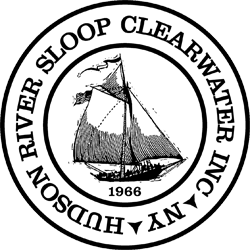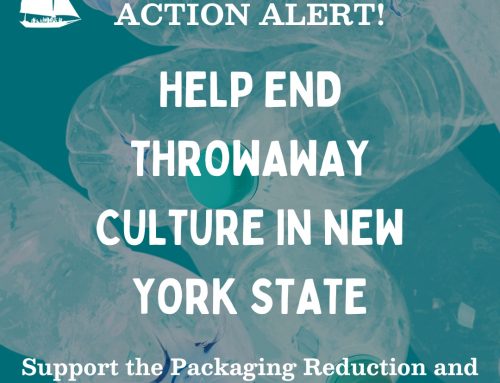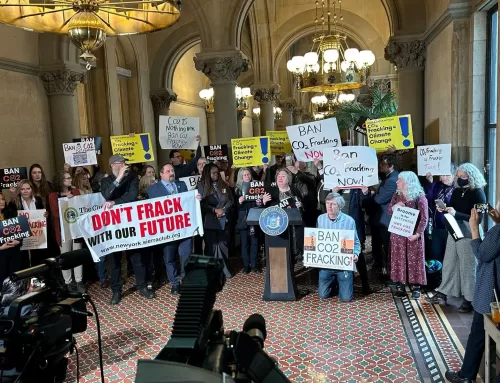Leading environmental groups cite designation as foundation for region’s future
HUDSON VALLEY—America’s Great Waters Coalition has declared the Hudson Estuary and watershed as one of the nation’s “Great Waters,” recognizing the river’s national importance and laying the groundwork for more effective federal contributions to the river’s restoration, according to leading river advocates. Building on the Hudson River’s reputation as the birthplace of the modern environmental movement and its naming as an American Heritage River, this new designation validates and reinforces the vision a broad array of partners has established for sustainable development centered on protecting the region’s natural resources and connecting more people to these irreplaceable treasures.
The heads of the region’s most prominent environmental organizations—Jeff Rumpf, executive director of Hudson River Sloop Clearwater; Barbara Kendall, coordinator of the Hudson River Watershed Alliance; Joan K. Davidson, chair of the OurHudson Steering Committee; Paul Gallay, president and Hudson Riverkeeper; and Ned Sullivan, president of Scenic Hudson—proclaimed that with this designation, now is the time to focus on a new model for federal involvement on the Hudson River that will sustain the estuary as a natural resource and a foundation for creating a sustainable economic future for the valley. They noted that the template for action in the region is embodied in New York State’s Hudson River Estuary Program Action Agenda, which has developed a regional vision for the environment and compatible economic development that builds on the valley’s history of innovation and leadership.
“Great Waters” is a designation bestowed by America’s Great Waters Coalition, which consists of 70 local, regional and national organizations that believe that speaking with a united voice and working together will help nationalize clean water, habitat restoration, watershed-based planning and public education efforts throughout the country as well as strengthen each region’s local efforts. New York State is in a leadership position to garner federal support and attention for the Hudson because of the New York State Department of Environmental Conservation’s Hudson River Estuary Program, which has developed a regional vision for the environment and compatible economic development that builds on the Hudson Valley’s history of innovation and leadership. Visit http://www.dec.ny.gov/lands/4920.html for more information about the Hudson River Estuary Program.
Shared goals for a healthy, livable and prosperous valley
The valley’s residents, visitors, communities and businesses will benefit from:
- a swimmable river where water quality is regularly tested and reported, allowing the public to recreate safely in a Hudson that is free of sewage from outdated storm water and wastewater infrastructure;
- a fishable river where Hudson Valley residents can once again eat local fish without health concerns and limited commercial fisheries can thrive;
- completion of General Electric’s cleanup of toxic PCBs it dumped in the Hudson;
- a robust habitat restoration plan for the river that will allow communities to revitalize their waterfronts and attract new business and tourism investments.
Hudson River Estuary Added to “Great Waters” List
- 65,000 acres of the most important scenic, ecological and agricultural significance along the Hudson forever protected, with riverfront parks where people can experience the river’s majesty and power to inspire;
- a heritage trail on both sides of the river from Albany to New York City that affords walking, kayaking/canoeing and other recreational opportunities and ways to experience history in a region designated by Congress as a National Heritage Area;
- development of regional watershed plans to address surface water and storm water management needs;
- a Hudson River estuary that boasts vibrant land, water and wildlife, with protected land that will buffer the impacts of global climate change;
- the establishment of the Hudson River as a great learning resource and creating a “pipeline” of new green leaders through support and advocacy for comprehensive environmental-education programs;
- the establishment of effective diversity outreach and consistent dialogue efforts to all people along the river, focusing on environmental justice and staunch protection of our natural resources;
- a shifting of our focus to create a sustainable economy based on building eco-friendly green cities.
“Designation of the Hudson Estuary as a Great Water builds on years of work by the state’s Hudson River Estuary Program and its partner organizations to enhance the region’s environment and economy through watershed planning and restoration initiatives. This is a big step forward,” said Barbara Kendall, coordinator of the Hudson River Watershed Alliance.
“Today we are one Hudson—united for America’s First River. This is the beginning of a new prominence and a new day for Clearwater, our Hudson River partners and the Hudson River Estuary. Thank you to our partners who have worked to achieve this great accomplishment; the tide is turned, and our shared fortunes are rising,” said Jeff Rumpf, executive director of Hudson River Sloop Clearwater.
Joan K. Davidson, chair of the OurHudson Steering Committee, expressed, “Congratulations to all the people and organizations, big and small, that have worked together to win this national salute to the greatest of America’s Great Waters, from the Adirondacks to the Verrazano Narrows. Excelsior!”
“It’s fitting that the Hudson River should be recognized as a Great Water in this, the 40th anniversary of the Clean Water Act. Although we still haven’t achieved the act’s goal of a ‘fishable, swimmable’ Hudson, this designation is an important recognition and should stimulate the increased investments we need to achieve these important goals,” said Paul Gallay, president and Hudson Riverkeeper.
“The Hudson Estuary has for generations inspired the nation to develop environmental policies and compatible economic development strategies. With the recognition of the Hudson and the NY-NJ Harbor as one Great Water, we have a new opportunity to restore our shared waters, revitalize our waterfronts for public use and create jobs,” said Ned Sullivan, president of Scenic Hudson.
Connection to New York-New Jersey Harbor important to success of initiatives
The New York-New Jersey Harbor was named a Great Water in 2010, but the designation did not extend up the Hudson River at that time. The announcement of the entire Hudson River watershed as a Great Water acknowledges the natural hydrological connections between the harbor, the estuary and their tributaries and creates new opportunities for collaboration.
Roland Lewis, president and CEO of the Metropolitan Waterfront Alliance and co-chair of the Harbor Coalition, a leading advocate for the New York-New Jersey Harbor, stated, “The goal of the NY-NJ Harbor Coalition is to galvanize support for transforming our urban waterfronts with exciting parks and docks that can accommodate everything from kayaks to tall ships, plus restored natural areas, enhanced waterfront neighborhoods and vital and sustainable port operations. By joining forces with other regional advocates through the Great Waters Coalition, we can amplify our voices and work together to secure the investment needed to make this vision a reality and create a tide that really does lift all boats.”
Estuary advocates cited that their agenda and the interests of the Harbor Coalition were remarkably similar and that both regions could be more effective at meeting their shared goals by working together.
Media Contacts:
Julia Church, Clearwater, 845 265 8080, ext. 7112; commun@clearwater.org
Barbara Kendall, Hudson River Watershed Alliance, 914 474 2759; bkendall@hudsonwatershed.org
Tina Posterli, Riverkeeper, 914 478 4501, Ext. 239; tposterli@riverkeeper.org
Jay Burgess, Scenic Hudson, 845 473 4440, Ext. 222; jburgess@scenichudson.org



